Comprehensive Analysis of Statistical Data: HI6007 Assignment Solution
VerifiedAdded on 2024/05/31
|13
|1872
|264
Homework Assignment
AI Summary
This assignment solution for Statistics HI6007 thoroughly explores frequency distribution, ANOVA, and regression analysis. It begins with constructing frequency tables and histograms to analyze data distribution, followed by an ANOVA table to determine F and P values. The assignment further examines the coefficient of determination and analyzes coefficients, standard errors, and t-statistics. It also covers regression equations, assessing the relationship between variables, and interpreting regression coefficients. Finally, the solution predicts sales revenue based on price and advertising spots, providing a comprehensive overview of statistical concepts and their application. Desklib provides a platform to explore similar solved assignments and past papers.
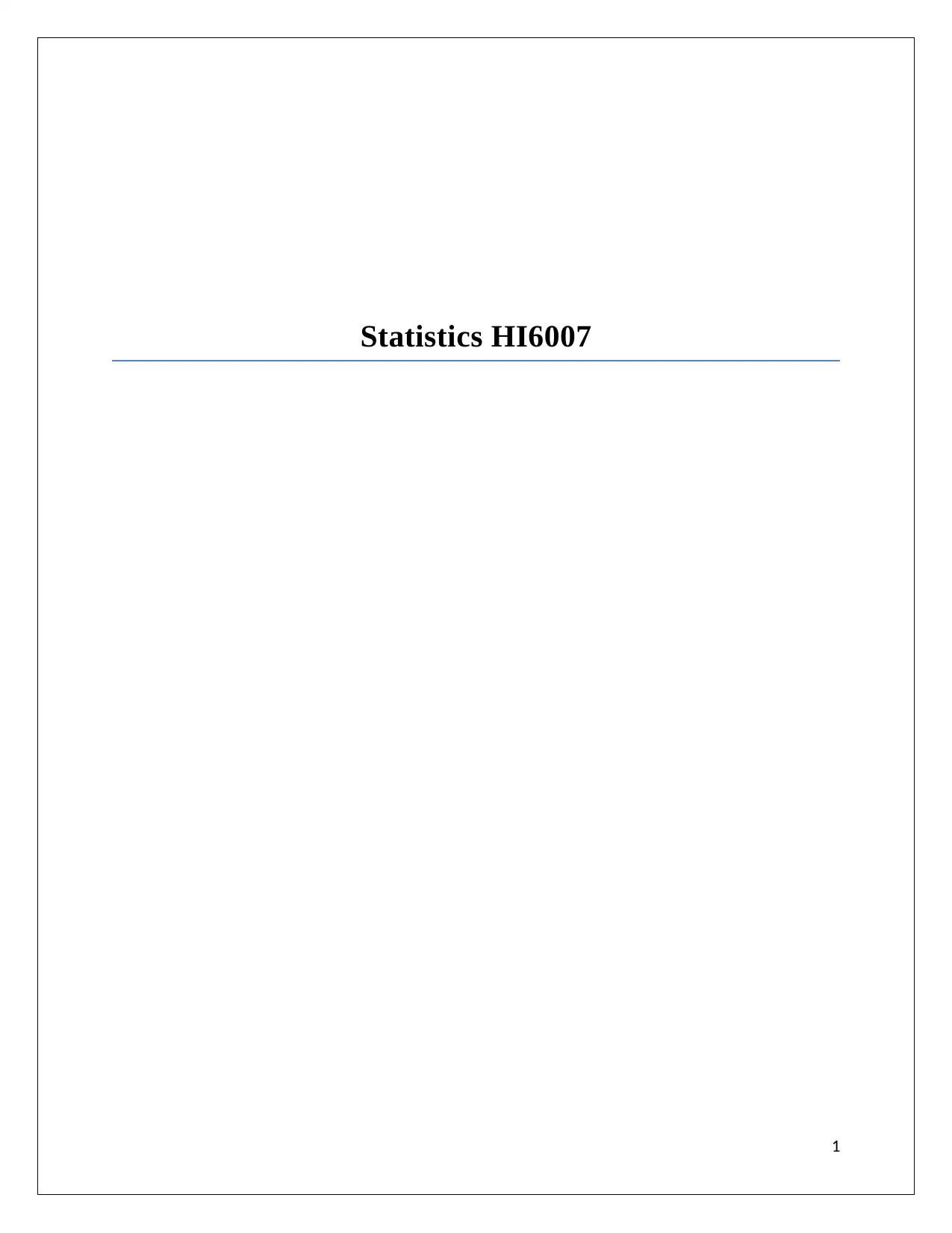
Statistics HI6007
1
1
Paraphrase This Document
Need a fresh take? Get an instant paraphrase of this document with our AI Paraphraser
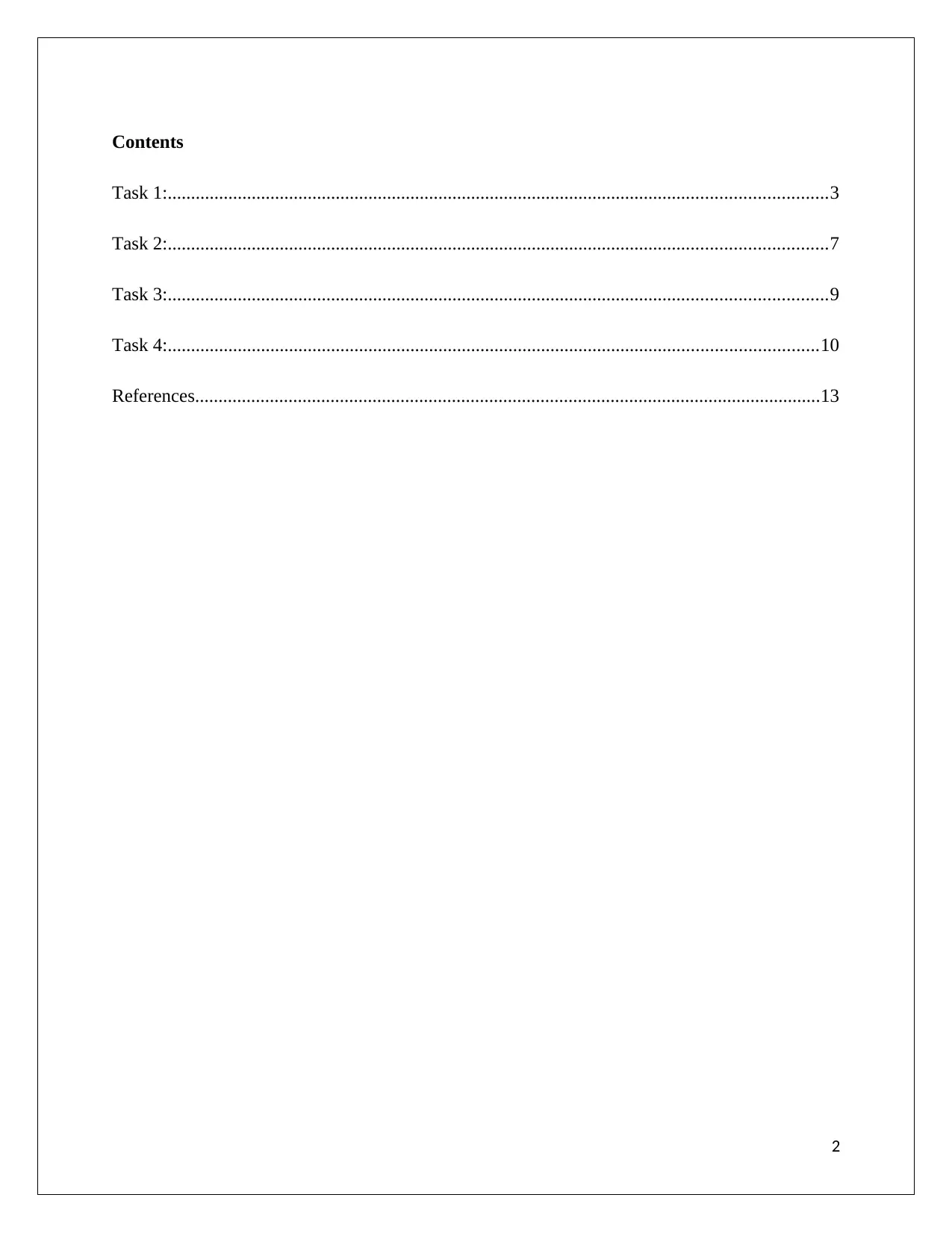
Contents
Task 1:.............................................................................................................................................3
Task 2:.............................................................................................................................................7
Task 3:.............................................................................................................................................9
Task 4:...........................................................................................................................................10
References......................................................................................................................................13
2
Task 1:.............................................................................................................................................3
Task 2:.............................................................................................................................................7
Task 3:.............................................................................................................................................9
Task 4:...........................................................................................................................................10
References......................................................................................................................................13
2

Task 1:
(a)
Class
Interval
Frequenc
y
Relative frequencies Frequency (%)
123-173 8 0.16 16
173-223 16 0.32 32
223-273 11 0.22 22
273-323 4 0.08 8
323-373 5 0.1 10
373-423 2 0.04 4
423-473 3 0.06 6
473-523 1 0.02 2
Total 50 1 100%
Analysis: The above set of data presents the distribution of frequencies into different class
intervals. The class intervals are segregated into accordance with the worth value of furniture’s
and has difference of 50. Then, these are allocated frequencies according to the class intervals.
3
(a)
Class
Interval
Frequenc
y
Relative frequencies Frequency (%)
123-173 8 0.16 16
173-223 16 0.32 32
223-273 11 0.22 22
273-323 4 0.08 8
323-373 5 0.1 10
373-423 2 0.04 4
423-473 3 0.06 6
473-523 1 0.02 2
Total 50 1 100%
Analysis: The above set of data presents the distribution of frequencies into different class
intervals. The class intervals are segregated into accordance with the worth value of furniture’s
and has difference of 50. Then, these are allocated frequencies according to the class intervals.
3
⊘ This is a preview!⊘
Do you want full access?
Subscribe today to unlock all pages.

Trusted by 1+ million students worldwide

The above class frequencies describes that the highest frequency belongs to 173-223 and lowest
to 473-524 and hence these are unevenly distributed.
Frequency distribution is the list or the table of frequency of different outcomes. Each table or a
list consists of frequency of values within a specific group, in this way distribution of the values
of outcomes in the sample forms a table. Frequency distribution is the group of summarized data
of outcomes which is divided into exclusive classes and the number of outcomes in the class.
Frequency distribution is the type of the data which has been used for both quantitative as well
qualitative. The table should be constructed in a proper way. Here we have keep the groping of
numbers to about 50, then we keep the intervals with the same number and then the class interval
should be multiply with the width. Relative frequency distribution is the type of frequency in
which the numbers which are falling in the category of observation is divided by the observation
of the total numbers. Relative frequency is calculated to look at the particular event as
comparison to total number of events. It is easy to determine the outcome with the help of this
frequency. Percentage frequency distribution is the process of calculating the data in percentage
of each data. Percentage frequency distribution is the method which can be expressed in the
tables, pie charts and bar graphs also. To calculate the percentage distribution we have to divide
the total no of observation with each data and multiply by 100.
(b)
1 2 3 4 5 6 7 8
0
5
10
15
20
25
30
35
Class intervals
Order value of furniture in $
Histogram showing relative frequency of
furniture order value
4
to 473-524 and hence these are unevenly distributed.
Frequency distribution is the list or the table of frequency of different outcomes. Each table or a
list consists of frequency of values within a specific group, in this way distribution of the values
of outcomes in the sample forms a table. Frequency distribution is the group of summarized data
of outcomes which is divided into exclusive classes and the number of outcomes in the class.
Frequency distribution is the type of the data which has been used for both quantitative as well
qualitative. The table should be constructed in a proper way. Here we have keep the groping of
numbers to about 50, then we keep the intervals with the same number and then the class interval
should be multiply with the width. Relative frequency distribution is the type of frequency in
which the numbers which are falling in the category of observation is divided by the observation
of the total numbers. Relative frequency is calculated to look at the particular event as
comparison to total number of events. It is easy to determine the outcome with the help of this
frequency. Percentage frequency distribution is the process of calculating the data in percentage
of each data. Percentage frequency distribution is the method which can be expressed in the
tables, pie charts and bar graphs also. To calculate the percentage distribution we have to divide
the total no of observation with each data and multiply by 100.
(b)
1 2 3 4 5 6 7 8
0
5
10
15
20
25
30
35
Class intervals
Order value of furniture in $
Histogram showing relative frequency of
furniture order value
4
Paraphrase This Document
Need a fresh take? Get an instant paraphrase of this document with our AI Paraphraser

Analysis: the above histogram presents the frequency distribution in accordance with the class
intervals. The histogram clearly presents that the 2nd and 3rd class interval have highest frequency.
A histogram is showing the relative frequency of the order value of the furniture and its class
interval. The histogram is symmetrical in shape; it is showing the class intervals from left to
right. The class interval is uniform but the order value of furniture is increasing in starting but
then it starts decreasing again it is increasing with the minor manner then it starts decreasing at
the end. The histogram shown in this figure is representing the percentage frequency distribution
method. It is showing the random distribution to the left from the right. It shows the data which
has the value more than zero. This is showing the positive histogram as in the starting case the
frequency starts increasing with high percentage then it starts decreasing with the huge
percentage. It has the several peaks which mean there are many classes in the data. There is no
permanent pattern of this histogram so we can’t define the exact shape. We can easily see the
data if different combinations are combined in it. The shape is not uniform we can say that the
shape is random distribution of different peaks which is showing the data which is increasing or
decreasing in percentage.
(c)
Measure of location describes the measures of central tendency which describes the middle point
of a data set. There are generally three measures for assessing measures of central tendency
namely, mean, median and mode. Mean describes the average value of a data set which is also
middle value. Median is the middle value and there are different set of level such as lower
quartiles, semi-quartiles and highest quartiles. Mode is the most occurred value in the data set.
The most appropriate shape of histogram in part b, can’t be define accurately as they are
increasing or decreasing. In second class interval that is 173-223 there is a huge increase in the
percentage frequency and in fourth class interval that is 273-323 there is a major fall in the
percentage frequency. In first class interval it has showing the 16 % frequency. From sixth class
interval the percentage of frequency is start decreasing. The most appropriate location for this
data set is the class interval of 173-223 which is showing the highest frequency percentage of
5
intervals. The histogram clearly presents that the 2nd and 3rd class interval have highest frequency.
A histogram is showing the relative frequency of the order value of the furniture and its class
interval. The histogram is symmetrical in shape; it is showing the class intervals from left to
right. The class interval is uniform but the order value of furniture is increasing in starting but
then it starts decreasing again it is increasing with the minor manner then it starts decreasing at
the end. The histogram shown in this figure is representing the percentage frequency distribution
method. It is showing the random distribution to the left from the right. It shows the data which
has the value more than zero. This is showing the positive histogram as in the starting case the
frequency starts increasing with high percentage then it starts decreasing with the huge
percentage. It has the several peaks which mean there are many classes in the data. There is no
permanent pattern of this histogram so we can’t define the exact shape. We can easily see the
data if different combinations are combined in it. The shape is not uniform we can say that the
shape is random distribution of different peaks which is showing the data which is increasing or
decreasing in percentage.
(c)
Measure of location describes the measures of central tendency which describes the middle point
of a data set. There are generally three measures for assessing measures of central tendency
namely, mean, median and mode. Mean describes the average value of a data set which is also
middle value. Median is the middle value and there are different set of level such as lower
quartiles, semi-quartiles and highest quartiles. Mode is the most occurred value in the data set.
The most appropriate shape of histogram in part b, can’t be define accurately as they are
increasing or decreasing. In second class interval that is 173-223 there is a huge increase in the
percentage frequency and in fourth class interval that is 273-323 there is a major fall in the
percentage frequency. In first class interval it has showing the 16 % frequency. From sixth class
interval the percentage of frequency is start decreasing. The most appropriate location for this
data set is the class interval of 173-223 which is showing the highest frequency percentage of
5

22% and the least appropriate location for the data set is the last class interval of 473-523
showing the lowest percentage frequency of 2%.
6
showing the lowest percentage frequency of 2%.
6
⊘ This is a preview!⊘
Do you want full access?
Subscribe today to unlock all pages.

Trusted by 1+ million students worldwide
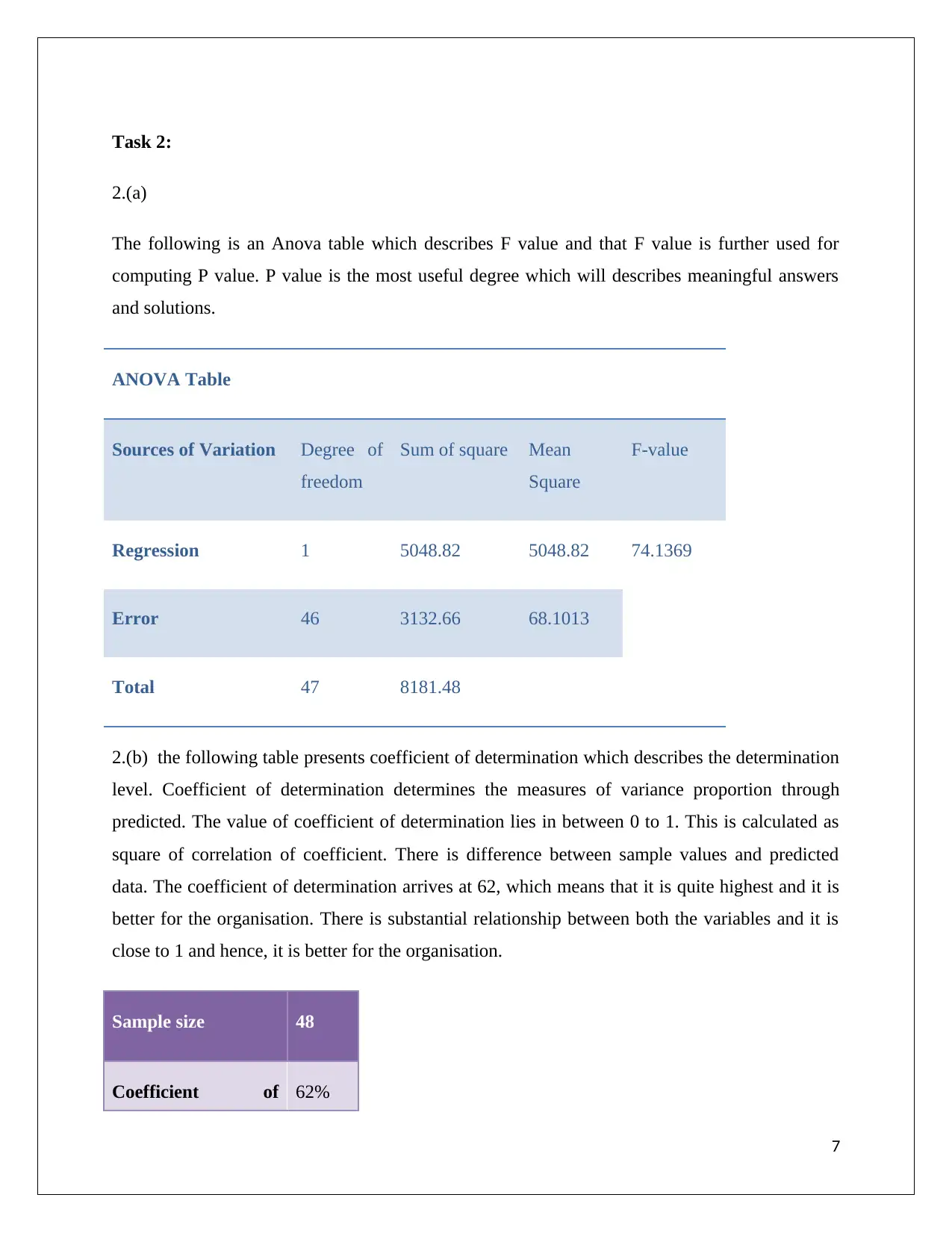
Task 2:
2.(a)
The following is an Anova table which describes F value and that F value is further used for
computing P value. P value is the most useful degree which will describes meaningful answers
and solutions.
ANOVA Table
Sources of Variation Degree of
freedom
Sum of square Mean
Square
F-value
Regression 1 5048.82 5048.82 74.1369
Error 46 3132.66 68.1013
Total 47 8181.48
2.(b) the following table presents coefficient of determination which describes the determination
level. Coefficient of determination determines the measures of variance proportion through
predicted. The value of coefficient of determination lies in between 0 to 1. This is calculated as
square of correlation of coefficient. There is difference between sample values and predicted
data. The coefficient of determination arrives at 62, which means that it is quite highest and it is
better for the organisation. There is substantial relationship between both the variables and it is
close to 1 and hence, it is better for the organisation.
Sample size 48
Coefficient of 62%
7
2.(a)
The following is an Anova table which describes F value and that F value is further used for
computing P value. P value is the most useful degree which will describes meaningful answers
and solutions.
ANOVA Table
Sources of Variation Degree of
freedom
Sum of square Mean
Square
F-value
Regression 1 5048.82 5048.82 74.1369
Error 46 3132.66 68.1013
Total 47 8181.48
2.(b) the following table presents coefficient of determination which describes the determination
level. Coefficient of determination determines the measures of variance proportion through
predicted. The value of coefficient of determination lies in between 0 to 1. This is calculated as
square of correlation of coefficient. There is difference between sample values and predicted
data. The coefficient of determination arrives at 62, which means that it is quite highest and it is
better for the organisation. There is substantial relationship between both the variables and it is
close to 1 and hence, it is better for the organisation.
Sample size 48
Coefficient of 62%
7
Paraphrase This Document
Need a fresh take? Get an instant paraphrase of this document with our AI Paraphraser
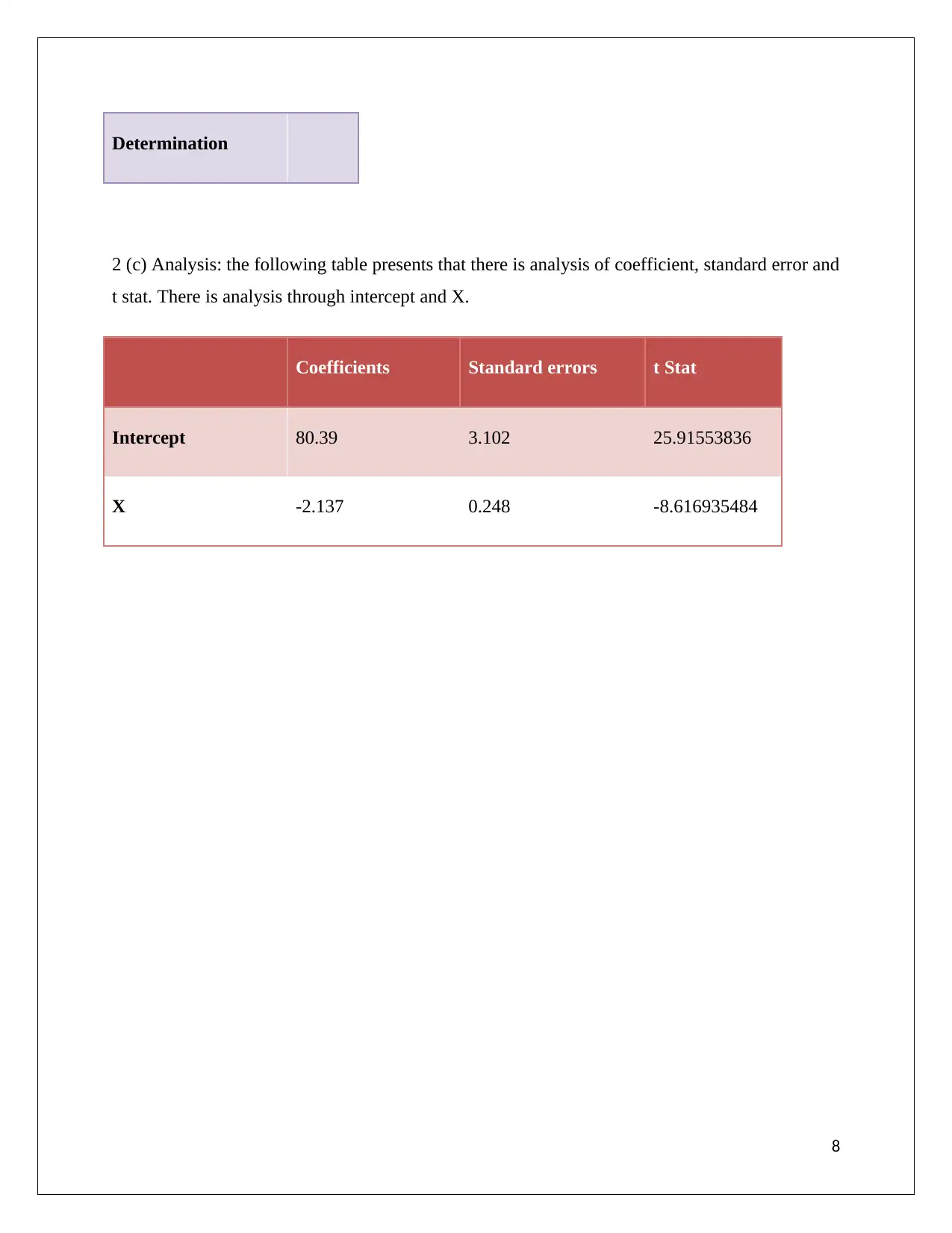
Determination
2 (c) Analysis: the following table presents that there is analysis of coefficient, standard error and
t stat. There is analysis through intercept and X.
Coefficients Standard errors t Stat
Intercept 80.39 3.102 25.91553836
X -2.137 0.248 -8.616935484
8
2 (c) Analysis: the following table presents that there is analysis of coefficient, standard error and
t stat. There is analysis through intercept and X.
Coefficients Standard errors t Stat
Intercept 80.39 3.102 25.91553836
X -2.137 0.248 -8.616935484
8
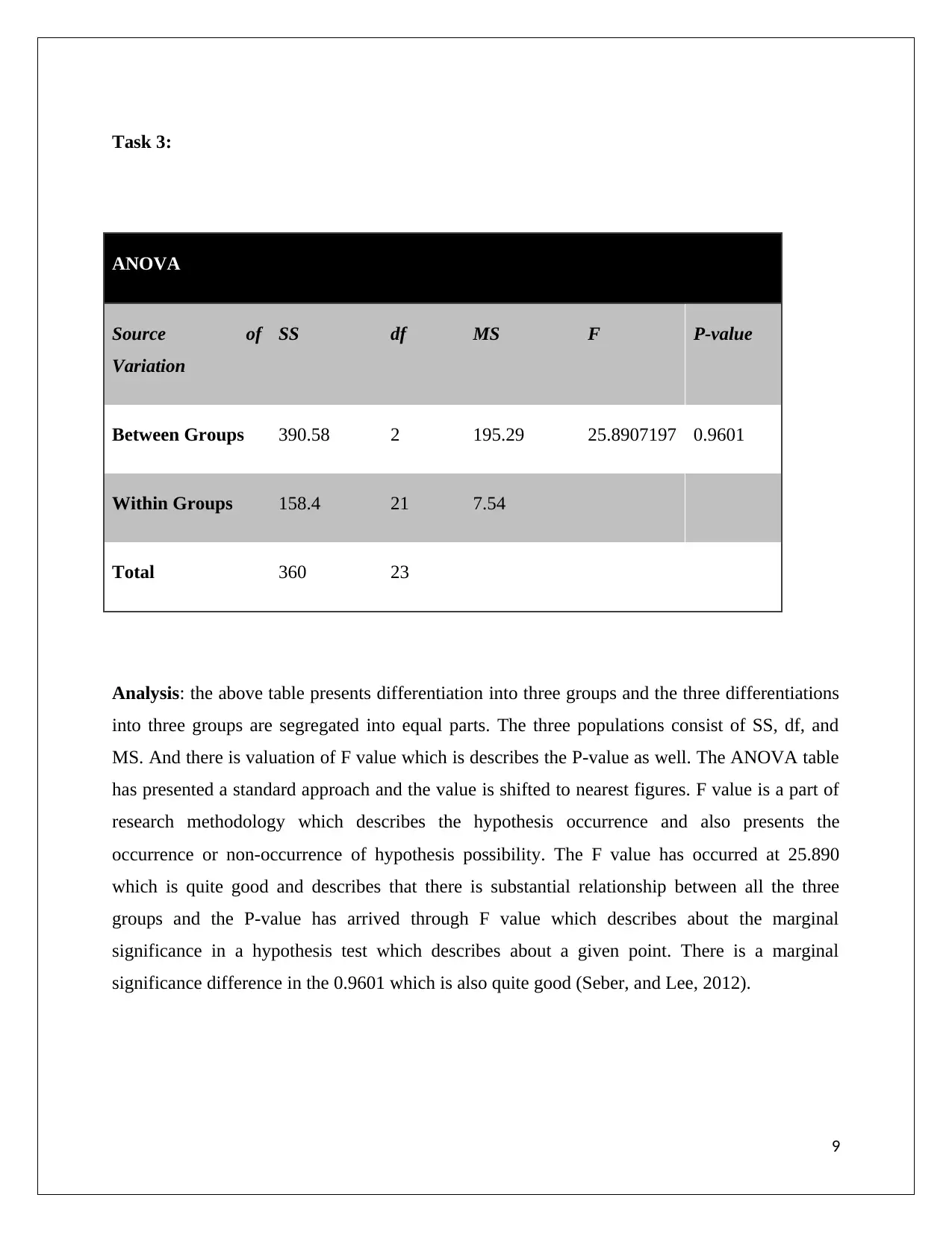
Task 3:
ANOVA
Source of
Variation
SS df MS F P-value
Between Groups 390.58 2 195.29 25.8907197 0.9601
Within Groups 158.4 21 7.54
Total 360 23
Analysis: the above table presents differentiation into three groups and the three differentiations
into three groups are segregated into equal parts. The three populations consist of SS, df, and
MS. And there is valuation of F value which is describes the P-value as well. The ANOVA table
has presented a standard approach and the value is shifted to nearest figures. F value is a part of
research methodology which describes the hypothesis occurrence and also presents the
occurrence or non-occurrence of hypothesis possibility. The F value has occurred at 25.890
which is quite good and describes that there is substantial relationship between all the three
groups and the P-value has arrived through F value which describes about the marginal
significance in a hypothesis test which describes about a given point. There is a marginal
significance difference in the 0.9601 which is also quite good (Seber, and Lee, 2012).
9
ANOVA
Source of
Variation
SS df MS F P-value
Between Groups 390.58 2 195.29 25.8907197 0.9601
Within Groups 158.4 21 7.54
Total 360 23
Analysis: the above table presents differentiation into three groups and the three differentiations
into three groups are segregated into equal parts. The three populations consist of SS, df, and
MS. And there is valuation of F value which is describes the P-value as well. The ANOVA table
has presented a standard approach and the value is shifted to nearest figures. F value is a part of
research methodology which describes the hypothesis occurrence and also presents the
occurrence or non-occurrence of hypothesis possibility. The F value has occurred at 25.890
which is quite good and describes that there is substantial relationship between all the three
groups and the P-value has arrived through F value which describes about the marginal
significance in a hypothesis test which describes about a given point. There is a marginal
significance difference in the 0.9601 which is also quite good (Seber, and Lee, 2012).
9
⊘ This is a preview!⊘
Do you want full access?
Subscribe today to unlock all pages.

Trusted by 1+ million students worldwide

Task 4:
a)
Regression equation makes analysis about the relationship between two variables. The
relationship between two variables describes about the dependency of one variable over another
variable. Both the variables have some sort of relationship between each other which is subject to
change and is also determines through application over one another. The equations are created
through variables a and b and the error is denoted through “e” (Cameron, and Trivedi, P.K.,
2013).
Coefficients
Intercept 0.805100
x1 0.497700
x2 0.473300
Sales = 0.805 - 0.5*price (in 1000's) – 0.473 * no. of advertising spots.
b)
The following table describes Anova with regard to regression and residual which has a total of 6
points. The calculation has been done in accordance with df, SS, MS ad the F value has arrived
at 80.11. The F value is quite higher which describes substantial relationship between three
groups. The F value is around 80.11 which is quite close with 1 and hence it is better for
organisation.
ANOVA
10
a)
Regression equation makes analysis about the relationship between two variables. The
relationship between two variables describes about the dependency of one variable over another
variable. Both the variables have some sort of relationship between each other which is subject to
change and is also determines through application over one another. The equations are created
through variables a and b and the error is denoted through “e” (Cameron, and Trivedi, P.K.,
2013).
Coefficients
Intercept 0.805100
x1 0.497700
x2 0.473300
Sales = 0.805 - 0.5*price (in 1000's) – 0.473 * no. of advertising spots.
b)
The following table describes Anova with regard to regression and residual which has a total of 6
points. The calculation has been done in accordance with df, SS, MS ad the F value has arrived
at 80.11. The F value is quite higher which describes substantial relationship between three
groups. The F value is around 80.11 which is quite close with 1 and hence it is better for
organisation.
ANOVA
10
Paraphrase This Document
Need a fresh take? Get an instant paraphrase of this document with our AI Paraphraser

df SS MS F
Regressio
n
2 40.700000 20.350000 80.118110
Residual 4 1.016 0.254
Total 6 41.716000
(c) Regression coefficient is a measure which determines the dependability of one variable over
other. Regression is a powerful means which describes regarding dependency of one variable
over another variable (Fox, 2015).
(d)
Analysis: The advertisement cost is around 81% which can vary into both direction in + or -. The
slope coefficient assesses the independent variable and measure the sensitivity level of the
independent variable as well. There is essential that there must be relationship between both the
variables and there must be assessment of impact of one factor over another.
(e)
Price of phones x1 20
Advertising spot x2 10
Sales revenue of
mobile phones y
9.62
11
Regressio
n
2 40.700000 20.350000 80.118110
Residual 4 1.016 0.254
Total 6 41.716000
(c) Regression coefficient is a measure which determines the dependability of one variable over
other. Regression is a powerful means which describes regarding dependency of one variable
over another variable (Fox, 2015).
(d)
Analysis: The advertisement cost is around 81% which can vary into both direction in + or -. The
slope coefficient assesses the independent variable and measure the sensitivity level of the
independent variable as well. There is essential that there must be relationship between both the
variables and there must be assessment of impact of one factor over another.
(e)
Price of phones x1 20
Advertising spot x2 10
Sales revenue of
mobile phones y
9.62
11
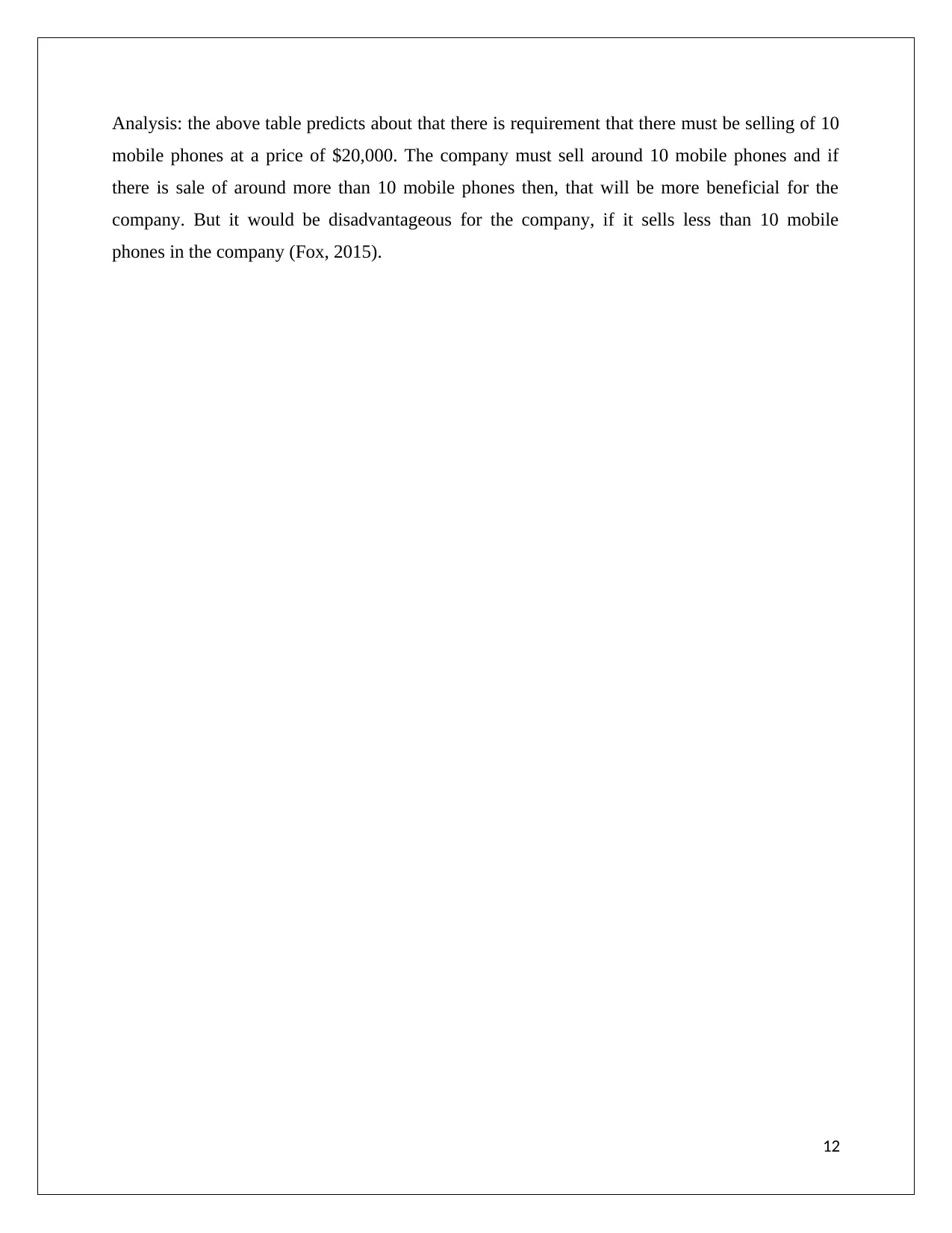
Analysis: the above table predicts about that there is requirement that there must be selling of 10
mobile phones at a price of $20,000. The company must sell around 10 mobile phones and if
there is sale of around more than 10 mobile phones then, that will be more beneficial for the
company. But it would be disadvantageous for the company, if it sells less than 10 mobile
phones in the company (Fox, 2015).
12
mobile phones at a price of $20,000. The company must sell around 10 mobile phones and if
there is sale of around more than 10 mobile phones then, that will be more beneficial for the
company. But it would be disadvantageous for the company, if it sells less than 10 mobile
phones in the company (Fox, 2015).
12
⊘ This is a preview!⊘
Do you want full access?
Subscribe today to unlock all pages.

Trusted by 1+ million students worldwide
1 out of 13
Related Documents
Your All-in-One AI-Powered Toolkit for Academic Success.
+13062052269
info@desklib.com
Available 24*7 on WhatsApp / Email
![[object Object]](/_next/static/media/star-bottom.7253800d.svg)
Unlock your academic potential
Copyright © 2020–2025 A2Z Services. All Rights Reserved. Developed and managed by ZUCOL.




